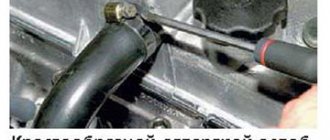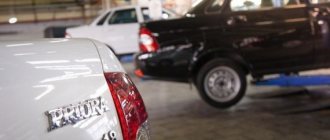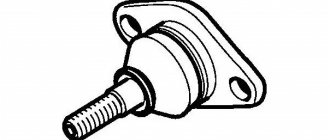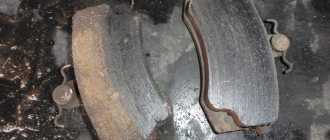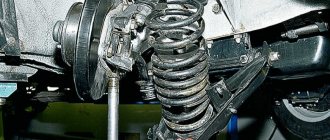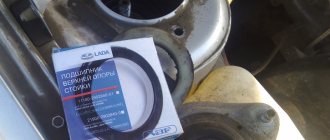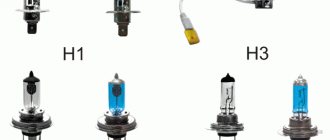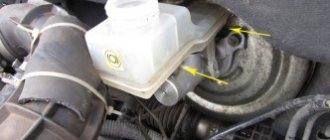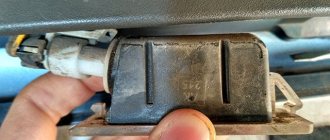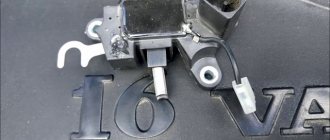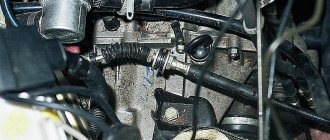The ball joint is one of the most important components of the front suspension of front-wheel drive cars, including the Lada Kalina. The main purpose of the ball joint is to be the connecting link between the steering wheel hub and the suspension arms. That is, during vertical movement, the hub rotates, but the horizontal position of the wheel remains unchanged. The condition of the ball joint should be carefully monitored. Otherwise, there is a high probability of serious consequences, especially if the breakdown occurs while driving. If the ball joint fails, the wheel will turn outward and the car is guaranteed to fall onto the wing. If you imagine such a situation at high speed, there is a high probability that its development will lead to a serious accident.
Characteristics of the ball joint on the Lada Kalina
This unit holds the wheel in a certain position, while at the same time allowing the hub to rotate and maintain horizontal stability.
The ball joint is called because of the ball-shaped tip. Structurally, it is a cone-shaped unit. The Lada Kalina uses a modern collapsible element, although the first VAZ models had stamped assemblies from several parts, and then cast structures. The ball joint installed on a Lada Kalina car, regardless of modification and generation, has a standard device that includes several main components:
- frame;
- a part in the form of a cone (another name is “finger”);
- rubber protective boot (prevents dirt and dust from entering).
The main elements are made of high quality steel. This is due to the fact that during operation the working parts are constantly exposed to load, friction and, as a result, high temperatures. The only exception is the hollow part of the body, which is covered with polymer materials. Plastic is mainly used for these purposes.
The main advantage of the Kalina ball joint is the extreme simplicity and efficiency of the design, which allows the contacting parts to move freely at equal angles.
Looking at the structure of the ball in more detail, it can be noted that it is actually a steel finger, which on one side ends with a tip in the form of a small ball. The tip rests on a plastic (or polyurethane) gasket. The bushing and ball end are located in the body and are rolled to prevent flyout. The body is additionally galvanized against corrosion. It is fixed to the upper or lower control arm and the threaded part is secured with a knuckle nut. Thanks to this, the fist is not fixed too tightly, which allows it to rotate along with the wheel hub, and the vertical position is maintained when the vehicle’s suspension is operating.
The ball joint is a fairly reliable and durable unit if you follow the operating rules. The long service life of the ball joint is possible thanks to the lubricant located in the part of the housing where it comes into contact with the working part. Insufficient lubrication, its leakage and moisture entering the internal cavity can cause premature failure of the entire assembly. To protect the working parts, a special boot made of rubber that is resistant to aggressive environments is used.
In order for the ball joint to last as long as possible, every car enthusiast should check the condition of the suspension from time to time, paying special attention to the rubber boots. There should be no cracks or other visible damage on their surface
If there are defects, it is recommended to check the condition of the entire assembly for wear.
Diagnostics of ball joints and reasons for their failure
Like all budget front-wheel drive cars, the Lada Kalina is equipped with a MacPherson-type front suspension. Briefly, the design consists of an upper support in the form of a strut with a shock absorber and a spring, and a lower support in the form of a wishbone. This lever is connected to the wheel hub (via the steering knuckle) using a ball joint. The design is elementary and therefore reliable, but the presence of moving elements makes diagnostics a difficult task, requiring certain skills and knowledge.
Signs of a ball joint malfunction
The most common symptoms of problems with this unit include the following:
- when driving at low speed over uneven surfaces, a knock is heard from the front suspension;
- when turning the steering wheel, a slightly greater force is required;
- when turning the steering wheel, the front suspension begins to creak;
- Tires wear out differently;
- The car pulls to the side when driving in a straight line.
But it is impossible to diagnose only a ball joint based on these signs, since these same symptoms may indicate problems with the shock absorber strut, wheel bearing or suspension arms. There are a number of methods for independently identifying faults that are not very complicated.
Diagnostic methods
| Options | Performance |
| The first and most accessible is a hearing test. | To do this, it is better to use the help of a second person. The engine must be turned off and the vehicle placed on a level surface. Have a helper rock the car. At this time, you need to listen to identify any extraneous sounds coming from the ball joint. Unfortunately, despite the simplicity of the method, it will not be informative for inexperienced car enthusiasts, since it is difficult for a beginner to localize the source of knocking and squeaking. |
| The second method is similar to determining whether a wheel bearing is faulty. | To do this, you need to check the wheel play using the rolling method. First you need to hang the desired wheel using a jack. Next, holding the lower and upper points of the wheel, you need to swing it in different directions with your hands. Ideally there should be no backlash. If there is play, this may indicate trouble with the ball. On the other hand, play may indicate problems with the wheel bearing. |
| The third method involves diagnosis by touch. | To do this, you need to place your palm on the support so that your palm simultaneously rests on both the body and the ball-shaped tip. At this time, the assistant should swing the wheel hanging on the jack; in this situation, you can easily feel the degree of play of the ball joint. |
It should be taken into account that on non-original supports there are special diagnostic holes that allow you to determine how worn the tip is. In addition, you can find out about problems with the ball by looking at the condition of the protective boot. Even small cracks can cause grease to leak and dirt and dust to enter. As a result, this results in accelerated wear of the unit and a significant reduction in service life.
Causes of ball joint malfunctions
Among the most common are mechanical damage and natural wear and tear, which can be significantly accelerated by a number of factors.
Boot rupture
This is one of the most common reasons for ball joint failure. A working boot should protect internal working elements from moisture, dirt, dust, etc. As a result, the lubricant ceases to perform its functions and increased wear of parts begins. The boot is made of rubber. This means that in the summer and at low temperatures in winter, the protective boot is susceptible to destruction.
Off-road
When driving on uneven surfaces most of the time, the ball joint wears out much more intensely. This is especially true for Russia, where the problem with roads is familiar to every motorist. Based on this, you should not rely on the service life indicated by European auto parts manufacturers. Usually it is better to change much earlier, because foreign brands do not take into account the condition of our roads.
Inadequate or absent lubrication
If there is heavy wear, it should be added in a timely manner, otherwise increased friction of the metal parts will lead to heating and rapid wear of the ball. Typically, this situation leads to severe grinding of the ball-tip pin, resulting in an increased gap and the pin dangling in the socket.
When the car starts to move off-road or on uneven surfaces, the pin may jump out of the housing (clip) with increased clearance. This is usually accompanied by a characteristic knock (knocking from one of the wheels) in the front suspension.
How to change a ball joint on a viburnum with your own hands
Lada Kalina Station wagon PORT WINE NOT LIKE EVERYONE Logbook Rear door lock
The ball joint is an important part of the car’s suspension, responsible for turns and vertical movement of the wheel. The quality of our roads, and sometimes driving style, lead to this part failing. And although the VAZ 2110 at one time became a fundamentally new car, ball failure on it happens no less often than on Samara class models. In this case, replacement is necessary.
Where is the ball joint located on the VAZ 2110
Based on the fact that this part is involved in turns, it is located behind the front wheels - on the left and right. This mechanism received the circuit, as well as all the sores, from the VAZ 2108 - the first Samara, and passed it on to all subsequent cars of the 110 class.
Many people mistakenly believe that there are 2 ball joints in a car, while forgetting that in addition to the upper ones, there are also lower ones. The diagram clearly shows that there are two ball wheels on one wheel - one at the top, one at the bottom.
Causes of malfunction
It is the ball joint that is responsible for the smooth passage of uneven areas. In a normal situation, the gap between the finger and the body is constant, and the finger rotates freely. When worn, it begins to wobble from side to side - the gaps increase, and sooner or later it may break. Constant driving on uneven roads can significantly shorten the life of the ball joint.
There are cases when even new parts broke. When driving, this joint experiences heavy loads, and if the wheel falls into a hole at high speed, the support can be torn out of its socket.
In a normal situation, the hinge is covered with a special boot. If the latter breaks, the support loses protection from external influences. If liquid gets on it, corrosion can begin, and if any solid particles get in, abrasive wear can occur.
Do I need to change
Inexperienced drivers often wonder: is it necessary to change? If you notice any of the indicated signs, you need to change it.
Symptoms of a problem
One of the main signs of failure is uneven tire wear. An experienced car enthusiast knows that in order to wear tires evenly, it is necessary to periodically change places - right to left, front to rear, but if the tire on one wheel “goes bald” noticeably faster, you need to check the ball joints of that wheel. Other signs of damage include:
- suspicious knocking in the wheel area;
- strange squeaks when turning;
- the wheel wobbles from side to side even when driving in a straight line;
- It became much more difficult to turn the steering wheel (on cars without power steering).
At the slightest suspicion, you need to check, since a breakdown of the support can even lead to the loss of a wheel, which will create an emergency situation on the road.
Diagnostics
You don't need any expensive equipment or a service station to check. Although it doesn’t hurt to contact the service, there are a couple more ways to check.
First way
- Jack up the car so that the front wheel hangs freely.
- Grab it firmly and start pumping. If there is a lot of play, the ball will have to be changed.
For the second method, you will need an inspection hole.
Second option
- Just like in the first method, they lift the car.
- Insert a pry bar or crowbar into the gap between the ball and suspension arm. Backlash, if there is any, can be noticed without difficulty.
A normal indicator is considered if the wheel remains motionless in both methods.
What will you need for replacement?
First of all, you need a ball joint remover for work.
Puller options in the photo
- spanner 17;
- socket wrench 19;
- wheel wrench;
- jack;
- mount;
It would be a good idea to call a friend who will hold the pry bar while you carry out other operations.
Options for choosing parts in the photo
How to change: step-by-step instructions
It's better to work in a pit.
Use a jack to lift the front of the car from the problem side. Unscrew the fastening nuts and remove the wheel. Unscrew the nut that secures the ball pin. Then remove the bolts located along the edges of the support - the fastening to the steering knuckle. Insert the puller and squeeze the finger out of the lever (see photo). Remove the support using a puller. If you don’t have a puller, you can use a hammer (see photo)
Holding your finger with the reinforcement, knock it out with a hammer. Ask a friend to carefully press the lower end of the lever with a pry bar. Removing the old part
They put a new one in its place and bolt it to the steering knuckle. Manually pointing your finger into the eyelet, ask a friend to slowly lower the lever. Secure the nut that secures the pin. Return the wheel to its place and lower the car.
The ball joint on modern Vases from 2108 to Granta also changes.
Video of replacement for VAZ 2110
The operation, which is often performed at a service station, can be done at home even by one car owner. But if you have a friend, the operation will take up to an hour, and the cost will be several times cheaper.
Carrying out repair work
Replacing ball joints on a VAZ 2110, as on all other front-wheel drive cars, cannot be completed successfully without a special puller. Its price in stores is 300-400 rubles, but it will bring much more benefits. Knocking out a ball with a hammer or crowbar is a very difficult task.
It got to the point that, in the absence of a puller, I had to beat my finger and torture it with a crowbar. As a result, I threw the toad off my neck and decided to go to the store, but my finger was flattened and it was impossible to tighten the nut (which was also flattened, since at first I didn’t tighten it completely).
Without this nut, I had to drive over potholes and potholes (fortunately our roads are perfectly “smooth”) to the store. I was afraid that the wheel would fall down and my finger would pop out. But this did not happen; the journey was about 7-8 km in total. (in both directions) on dirt roads and asphalt roads.
Because of the loads that the road placed on the ball joint of the VAZ 2110, the finger did not pop out, but the knocking noise disappeared (apparently, the body was clogged). So, for repairs you will need:
- Ball puller for front-wheel drive VAZ cars.
- A 19" wrench for unscrewing the hub bolts.
- Jack.
- Keys to "17" and "22".
- A kit for replacing the ball (in addition to it, a boot and a nut if necessary, as well as fastening bolts with engraving washers).
- A small amount of CV joint lubricant or Litol-24.
Now you can begin the repair; it will take 10 minutes, maybe even less. Here's the strategy:
- Loosen the wheel mounting bolts.
- Lift and remove the wheel.
- Turn the steering wheel to the side (for convenience).
- Using a key set to “22”, unscrew the nut from the ball joint pin of the VAZ 2110.
- Using the “17” wrench, unscrew the two bolts securing the ball housing to the hub.
- Put the puller on and screw in its axle until the pin comes out of the hole in the hub.
- Fill the boot of the new ball with a small amount of lubricant.
- Install the ball, attach a nut and two bolts.
- Tighten all threaded connections.
- Install the wheel.
That's all, replacing the ball joint on a VAZ 2110 is complete; it turned out to be very easy to do it yourself. The work is carried out equally on the left and right sides of the car, so there is no point in describing the repairs to each separately.
Hi all! In search of a knock in the area of the front right wheel, I decided to change the right ball joint. I bought a ball BZAK for 300 rubles, it seems like that’s what they install from the factory.
I also purchased a ball puller for 400 rubles.
I didn’t like the puller, it’s not convenient, the hole is too small, you’ll be stuck in it.
On the new ball joint, I removed the boot and filled it with lithol.
I removed the old ball joint in five minutes. For some reason, it pressed out without a characteristic click.
The old ball joint turned out to be in order, no play, except that the finger moved too easily.
I thought it would be possible to change the ball joint quickly and without problems, but it turned out as always. When trying to pull the new ball onto the steering knuckle, the grenade drive was pulled out. As it turned out, it is very difficult to push the drive back in alone. The easiest way would be to remove the grenade from the hub; to do this, unscrew the hub nut.
But this creature was stuck tightly, even with the help of a meter-long pipe I couldn’t get it off, I just broke the knob.
I had to take “help from a friend.” With two people, you can push the drive in without removing the grenade; one presses the lower lever, and the second pushes the drive into the grenade. Getting into the hole is difficult but possible. As a result, the two of us pushed the drive into place in about ten minutes, and in one minute, I stuffed the grenade with new lubricant.
The ball was put in place in just a couple of minutes.
Conclusions:
As it turned out, the cause of the knock was not the ball, but the engine protection.
Note to yourself, for the future, never try to change balls and grenades alone. Together, this is done much easier and faster.
Wear or breakage of the ball joint is a serious malfunction that negatively affects the operation of the car and requires prompt elimination.
The most common signs by which you can determine the need to replace the ball are:
- Creaking in the area of the specified part when turning the steering wheel.
- A knocking noise that occurs primarily when driving on rough roads at low speeds. This is due to the increasing gap between the pin head and the body cavity, or rather its surface.
- Lack of stable movement when driving straight. Additional features are the presence of uneven tire wear with correct wheel alignment. You cannot rely only on this symptom, since it also appears with some other problems.
Since car owners do not always have the desire or opportunity to contact the appropriate service center, and may also not have the necessary tools at hand, a number of questions arise. In this case, drivers are interested in how to remove a ball joint without a puller. We will consider this procedure using the example of several cars of different brands.
Change ball joints on a viburnum with your own hands
Lada Priora Sedan Snezhka Logbook Replacing the support bearing
Hello. Today we’ll talk about how to replace ball and tie rod ends on a Lada Kalina with your own hands. Why ball and tie rod ends fail and how to diagnose their malfunction is written here
Before starting work, you need to prepare: a set of keys, a universal puller, a jack, WD-40 fluid, as well as new spare parts.
How to replace ball joints on a Lada Kalina - step-by-step instructions
1. Before starting work, apply a few drops of WD-40 to threaded connections that you think may have problems. They will be different for everyone, it all depends on the condition of the car, the roads on which it drives, and the attitude of the owner towards this car...
2. Unscrew the ball joints. There are two TORX bolts that are attached to the hub; for this we take an E12 head.
3. Afterwards, we proceed to the stabilizer strut, it must be unscrewed.
4. Bend down the lever with the ball joint.
5. Using a universal puller, press the ball joint out of the lever. If you don’t have a puller, you can use a crowbar, but in this case there is a high probability of damage to the CV joint boot if the crowbar comes off.
6. When the old ball is removed, take the new ball and attach it to the hub and lever.
7. Jack up the lever, using a jack to place it under the ball. This will compress the spring of the shock absorber strut and screw on the stabilizer bar.
Step-by-step instructions - how to replace tie rod ends on a Lada Kalina
- We unscrew the steering wheel in the direction opposite to replacing the steering tip.
- We remove the locking pin and unscrew the nut securing the tip to the stand.
- Now you need to “release” the tip mounting bolt.
- Using a puller, press the tip out of the stand. Some people use a hammer and simply knock out the tip.
- Next we unscrew the tip, this is done clockwise. If the adjusting sleeve starts to rotate, fix it using a wrench.
6
I draw your attention to the number of turns, it must be counted, this will save you from the need to go to a service station and do a wheel alignment
7. Assembly is performed in reverse order. If the car pulls to the side and the “trick” with counting the turns didn’t work, don’t be lazy and do a wheel alignment.
The result of the work done should be the disappearance of play and knocking, which are an integral part of chassis malfunctions.
That's all for me, thank you all for your attention, I hope everything worked out for you!? Until we meet again, take care of yourself and your car! Text belongs to: VAZ DIY repair
Text belongs to: VAZ DIY repair
Causes of malfunctions in the front suspension
| Cause of malfunction | Remedy |
| Noise (knock) in the suspension when the car is moving | |
| Telescopic suspension struts are faulty | Replace the racks |
| The bolts holding the stabilizer bar to the body are loose. Wear of rubber cushions of guy wires or barbells | Tighten the bolts, replace worn cushions |
| The fastening of the upper support of the suspension strut to the body is loose | Tighten the upper support mounting nuts |
| Settlement, destruction of the rubber element of the strut support | Replace the rubber element of the strut support |
| Wear of rubber-metal hinges of suspension arms, braces or stabilizer bar struts | Replace the hinges |
| Wear of the ball joint of the suspension arm | Replace the ball joint |
| Settlement or breakage of the suspension spring | Replace the spring |
| Destruction of compression progress buffer | Replace buffer |
| Increased wheel imbalance | Balance the wheels |
| Liquid leaking from the strut | |
| Wear or destruction of the rod seal; nicks, scuffs on the rod, damage to the chrome coating; shrinkage or damage to the strut housing O-ring (shock absorber reservoir) | Replace the shock absorber strut |
| Frequent suspension breakdowns | |
| Suspension spring draft | Replace the spring |
| Shock absorber not working | Replace the shock absorber strut |
| Insufficient resistance of the suspension strut during recoil stroke | |
| Leaking recoil valve or bypass valve; insufficient amount of fluid due to leakage; scoring on the cylinder and piston ring; wear or damage to the fluoroplastic layer of the guide bushing; recoil valve spring settlement; the presence of foreign impurities in the liquid | Replace the shock absorber strut |
| Compression valve leaking; insufficient amount of fluid due to leakage; rod wear or damage to the fluoroplastic layer of the guide bushing; the presence of foreign impurities in the liquid; wear, deformation or destruction of compression valve discs | Replace the shock absorber strut |
| Increased ball joint clearance | |
| Wear of the rubbing surfaces of the ball joint parts as a result of contamination caused by leaks or damage to the cover | Replace the ball joint |
| Moving the vehicle away from straight-line motion | |
| Different tire pressures | Set normal pressure |
| Violation of wheel alignment angles | Adjust wheel alignment |
| Destruction of the rubber element of one of the suspension strut supports | Replace the rubber element of the strut support |
| Uneven elasticity of suspension springs | Replace the spring that has lost its elasticity |
| Significant difference in tire wear | Replace worn tires |
| Increased front wheel imbalance | Balance the wheels |
| Increased tire tread wear | |
| Excessive acceleration with wheel slipping | Avoid hard acceleration |
| Frequent use of wheel locking brakes | When braking, do not allow the wheels to lock |
| Wheel alignment angles are incorrect | Adjust wheel alignment |
| Vehicle overload | Do not exceed the permissible loads specified in the instruction manual |
| Uneven tire tread wear | |
| Increased speed when cornering | Reduce speed when turning |
| Extensive wear on ball joints of suspension arms and rubber-to-metal joints | Repair the suspension |
| Wheel imbalance | Balance the wheels |
Have you ever encountered a situation where the suspension rattles (extraneous noises and knocks appear)? Were you able to diagnose the cause yourself?
Let us remind you that we previously told you how to protect the supports (nuts) of the front struts, and also why they install wishbone suspension arms.
Keywords: front suspension Lada Kalina | front suspension of Lada Granta | front suspension of Lada Priora | rear suspension of Lada Kalina | rear suspension of Lada Granta | Lada Priora rear suspension
Found an error? Select it and press Ctrl Enter..
LADA was included in the ratings of the best and worst cars of Autoreview
Activating the rear view camera on Lada XRAY
What should be the tire pressure of Lada Largus
How to install fog lights (PTF) on Lada Vesta
Spherical bearing
Lada Kalina Hatchback MyLittleFriend Kalinich Logbook Floating speed or Replacing the idle air control
A ball joint is a connecting unit that secures the steering wheel hub and suspension arms. The unit fixes the position of the wheel, which allows the hub to rotate, which in turn determines the stable movement of the car.
The support is represented by a cone-shaped part with a movable spherical tip. Over the years, the supports have changed their design. At first these were stamped parts welded together.
Stamping was replaced by cast and then collapsible supports. In addition, the units come with grease nipples, serviceable and maintenance-free. Each type has its own design features and is suitable for a specific model.
A modern support of any type, including that installed on the Lada Kalina we are considering, has the following design:
- frame;
- a cone-shaped element, popularly called a “finger”;
- Anther protects the body from dust and moisture.
All these parts are usually made of steel, since they are in constant motion, friction and overheating. And only the recess of the support body is covered with a polymer material, most often plastic.
Helpful information:
You can get professional advice when selecting a product by calling 8 (calls within Russia are free).
The ball joint is one of the most important components of the front suspension of front-wheel drive cars, including the Lada Kalina. The main purpose of the ball joint is to be the connecting link between the steering wheel hub and the suspension arms. That is, during vertical movement, the hub rotates, but the horizontal position of the wheel remains unchanged. The condition of the ball joint should be carefully monitored. Otherwise, there is a high probability of serious consequences, especially if the breakdown occurs while driving. If the ball joint fails, the wheel will turn outward and the car is guaranteed to fall onto the wing. If you imagine such a situation at high speed, there is a high probability that its development will lead to a serious accident.
Replacement
- The first step is to soak the fasteners in WD-40 engine oil for a day to make the boiled parts easier to remove. It is advisable to do the impregnation twice, one and a half to two hours apart, and leave until the next day.
- Now we begin the most difficult dismantling work. Raise the front of the car and remove the wheel.
- Unscrew the fasteners holding the supports. There are only two bolts that can be removed with a 12mm wrench.
We dismantle the stabilizer strut.
To remove the supports, you must first bend the lever down a little. We arm ourselves with a puller and press the part out of the lever. An analogue of a puller can be an ordinary crowbar, which is likely to be found in every home of the real owner. But when pressing out the support, you need to be extremely careful: you can damage the boot, which is quite fragile, especially on the Lada Kalina. After dismantling, we install a new support and reassemble in the reverse order. Now we do the same with the rear supports.
Of course, repair work on the suspension is not as simple as, for example, replacing a steering rack or muffler, but if you use competent instructions and patience, everything will work out. We wish you good luck and good roads!
How to check a ball joint Several ways - useful information
- Drive the car onto an inspection hole or overpass. A flat surface is possible, but access to the bottom of the car is desirable;
- Squeeze the handbrake, turn on neutral speed, jam the rear wheels with special shoes;
- Jack up the left and right front wheels alternately, holding one hand at the top of the tire and the other at the bottom. With some effort, try to shake the wheel up and down. If you hear a slight knock and play, then it is necessary to urgently replace the ball joint. Otherwise, driving onto the highway is extremely dangerous. If there is no play, then you can proceed further.
- Natural wear and tear of vehicle chassis components;
- Exceeding the maximum permissible loads;
- Exposure to the negative effects of water, cold, dust, dirt due to damage to the protective boot on the ball joint;
- The actual absence of lubrication inside the product, which leads to a wedge.
- A characteristic and distinct knocking sound when driving over uneven surfaces and potholes;
- When turning the steering wheel, a grinding noise is heard and the force with which the turn is performed is increased;
- The car doesn't handle the road well. It feels like it's fluttering rather than moving;
- Uneven and rapid wear of car tires.
- Drive the car into the inspection pit of the garage;
- Putting on the handbrake, securing the rear wheels with shoes, you can turn on the first speed for reliability. Jack up the wheel;
- Some take off the wheels, some don't, depending on who you like. In principle they do not interfere;
- Armed with two keys on “17”, we unscrew the fastening of the ball joint to the spar. Just two bolts;
- For convenience, it is better to turn the steering wheel left or right. Using keys “14” we unscrew the support mount directly on the hub itself. Using a hammer and a wooden insert, carefully knock out the support itself from the saddle without damaging the brake hoses;
- Before installing a new one, you should walk a little with WD-40 liquid to remove rust. After wiping the socket with a dry cloth, lubricate it a little with Litol-24M graphite lubricant;
- Install the support and tighten the bolt. We do the same with the fastening;
- Then we move on to the second wheel or test the car on the track.
AutoFlit.ru
How to determine whether a ball joint is faulty
It is believed that the optimal method of checking the ball joint is to visit a car service center where there is a lift and an appropriate stand. There, specialists will be able to identify faults not only with the ball joint, but also with other elements of the vehicle’s suspension.
However, if the task is only to check the ball, then this can be done in garage conditions using just installation. Well, perhaps it would be desirable for the car to be parked on a pit or overpass. A faulty ball joint can be identified by the main symptom - knocking and free movement of the ball pin when a mount force is applied to it.
Quick check
First of all, you need to “listen” to the ball joint. However, for this it is better to take an assistant, preferably one who knows what sound a broken support makes and generally has some understanding of the elements of a car’s suspension. The verification algorithm is simple - one person rocks the car from side to side (in the direction perpendicular to the movement), and the second listens to the sounds coming from the suspension elements, in particular, from the ball joint.
If such rocking does not produce results, it is worth jacking up the car on the side where you want to check the support. Then, holding down the brake pedal (this is done to eliminate possible bearing play), try to swing the wheel in a direction perpendicular to the movement (that is, away from you and towards you). If there is play and/or “unhealthy” clanging sounds, then there are problems with the ball.
The play of the broken ball will be checked using a pry bar. So, the car needs to be jacked up, and the flat end of the mount placed between the lever and the steering axle. Then, while one person slowly turns the steering wheel, the second person presses on the pry bar. If there is play, it will be clearly felt and even visible to the eye. A similar procedure can also be performed without rotating the steering wheel, especially if the ball joint is already significantly worn.
Replacing a ball joint on a Lada Kalina
The instructions for carrying out work on the first generation Lada Kalina and the “two” are no different. This does not depend on the modification, for example, sedan, station wagon or hatchback (cross). You can do everything yourself. To do this you will need the following set of tools:
- wrenches or socket heads 17 and 19;
- TORX E12 head;
- special puller for ball joints.
You may also need a torque wrench to ensure optimal tightening of nuts and bolts, a pry bar, and a hammer to knock out the pin. As for the TORX E12 key, it can become useful when working with a ball joint on Kalina 2, where this fastener is used for fastening to the steering knuckle, and not a 17 bolt, as on Kalina 1st generation.
Rules for removing the ball joint
Before starting work, you should raise the parking brake lever all the way and use the jack to hang the desired wheel. The further process is as follows.
- Using a socket or a 19 mm wrench, unscrew the fastening nut, thanks to which the ball end is mounted on the wishbone.
- Use a special puller to remove the conical pin from its seat in the body.
- Using a 17 wrench (on Kalina 2, a TORX wrench), unscrew the fastening bolts that secure the ball to the hub knuckle.
- Using a pry bar, lower the lever lower. This will give you access to remove the ball joint.
To make the task easier, you can pre-treat the bolts and nuts with VD 40 or any similar liquid. This is true in some cases, but usually there are no problems with unscrewing nuts and bolts. If there is no puller for ball joints, you can remove the pin in another way:
- loosen the nut and leave it on the tip;
- Use a mounting spatula to press the lever from top to bottom;
- Use a hammer to knock the pin out of the body, thereby pressing it out of the seat.
If desired, the ball can be visually inspected and tested for compliance. To do this, the assembly is clamped in a vice. And with movements in different directions, the axial and other play of the finger in the socket is checked. The play should not exceed 0.7 mm; if there are large deviations in this indicator, the unit should be replaced; the ball joint cannot be repaired. If it is in order, but the rubber boot is damaged, you can only get by by replacing it. To do this, the support is dismantled and the boot is removed from it; before installing the cover, it should be filled with a suitable lubricant and fixed to the support.
Installing a new ball
Lubrication in the case will also be required for the other support; without lubricants, the unit will not last long. Installation is carried out in the reverse order of removal. To do this, you can use one of two methods.
- Install the support on the steering knuckle, then fix the lever and secure the nut to the tip.
- Install the assembly on the lever and only then bring them to the steering knuckle, then secure the structure with bolts.
In the case of using the second method, it should be borne in mind that there are some inconveniences due to difficulties in bringing the lever to the fist, therefore, if possible, it is better to prefer the first method. It is recommended to use a torque wrench to properly tighten the mounting nuts and bolts. Having installed a new support, you can operate the car as before. However, after an approximate mileage of about 100 km, it is imperative to check the tightening of all bolts and nuts. Then you can drive without any additional actions.
In general, replacing a ball joint on a Kalina can be done with your own hands, even by beginners. Contacting a car service is possible to save time, especially since it is inexpensive: usually no more than 250 rubles per side, not counting the cost of the unit.
DIY car suspension diagnostics
Suspension boots, bushings and silent blocks
| To determine the condition of the covers, you need to feel it with your hands. |
| These cases with deep cracks are not yet worn out, but their service life is almost running out. If you replace them now with new ones, then this cheap part will protect much more expensive ones from damage. |
| If the protruding edges of the rubber bushings of the rods, suspension arms or shock absorber eyes are cracked, then it makes sense to replace them |
| If the pin has moved from the center of the eyes to the edge, then the rubber bushing is badly worn or torn, so in this case only replacement with a new one is required. |
| To determine the wear of the silent blocks (these are rubber-metal hinges) of the suspension arms, you need to use a pry bar or a crowbar so that there is enough force to move the arm relative to the body. If there is play or a knock is heard, then it’s time to change the silent block. The same technique works for other hinges. In this case, the condition of the silent blocks cannot be determined with bare hands. |
xn--2111-43da1a8c.xn--p1ai
Changing the ball joint on a Lada Kalina photo and video
In the design of a car, the ball joint plays a very important role, since it bears all the load that the vehicle experiences
Also an important function is the level of inclination of the wheels. On the Lada Kalina, the factory ball joint is not very reliable, so many car enthusiasts replace the standard part with an analogue
Video on replacing a ball joint
The video material talks about replacing the ball joint of the Lada Kalina and the features of the process.
Ball joint replacement process
When you have decided on a spare part, you can carry out the replacement operation. So, let's look at the step-by-step process of changing the ball joint on Kalina:
- We dismantle the wheel.
The wheel has been removed! - We clean the ball joint and all surfaces that connect to it.
- Unscrew the fastening of the ball joints.
The ball mount is marked with an arrow. - The stabilizer link also needs to be unscrewed for easy replacement.
We unscrew the stabilizer mount for easy replacement of the Kalina ball joint - We bend the lever down.
- We take a special puller for balls and press it out of the lever seat.
- Installation is carried out in reverse order.
Using a jack, raise the lever and tighten the stabilizer mountInstalled a new ball joint on Kalina
Peculiarities
Consequences of untimely replacement of the ball joint
Harsh operating conditions, poor road surfaces, loads and passengers place a lot of stress and responsibility on the ball joint. Therefore, the condition of this node must be monitored regularly.
The entire load does not go to the ball joint itself, but to a small ball, which can fall out if worn out and worn out. If you remember, not so long ago you could see a Lada car on the road with a fallen ball joint.
Reasons for failure
There are several reasons why a ball joint may fall out. Let's consider the main ones:
- Wear.
The most common malfunction that occurs on cars. Inspecting the ball for wear - Insufficient lubrication in the boot leads to the fact that the finger begins to creak and may eventually simply break.
- The penetration of dirt and water into the ball contributes to the development of corrosion, which can affect the operation of the vehicle. At best, a wedge and the inability to turn the wheels; at worst, the car will fall onto the asphalt.
To avoid consequences, it is necessary to regularly diagnose and maintain ball joints.
Diagnostic operations
How can you diagnose the condition of ball joints on a Lada Kalina:
The first thing you need to pay attention to is the condition of the boot. If it has cracks or is torn, then it must be removed and the ball should be inspected.
We hang the wheel a little and swing it up and down with our hands. If there is play, then it’s time to replace the ball. The presence of a squeak, as well as heavy turning of the steering wheel, can also be signs that the ball joints are in critical condition. Instability in control, namely departure from the trajectory of movement to the left or right, with the steering wheel in a level position, indicates that the ball joint has failed.
It is almost impossible to determine the exact condition of the ball joint, but the above facts indirectly indicate the condition of the supports.
Ball selection, articles
The choice of ball joints for the Lada Kalina should be treated carefully, since it determines what loads the car can withstand:
Original
If you believe the spare parts catalog, then the original catalog number of the Lada Kalina ball joint is 2108-2904185. The average cost is 1000 rubles per piece.
Original Kalina ball joint produced by AvtoVAZ
Analogs
Belmag ball joint is an excellent option for replacing original spare parts
Let's consider possible options for replacing the original spare part:
| Weber | SS 2108-4185 | 500 |
| Master-sport | 1545601/E-PCS-MS | 500 |
| SCT | RM 485 | 500 |
| Denckermann | D110112 | 500 |
| Monroe | L70003 | 550 |
| Ruville | 917210 | 600 |
| Delphi | TC583 | 600 |
| Patron | PS3101 | 600 |
| Pekar | 2108-2904185 | 600 |
| Moog | LA-BJ-0063 | 650 |
| Pilenga | TS-P 3142 | 700 |
| TRW | JBJ 156 | 800 |
| Optimal | G3-199 | 1000 |
As you can see from the table, you can buy an analogue cheaper than the original. But don’t go to extremes and buy the cheapest.
TRW ball joint recommended for installation on Kalina
The process of replacing ball joints on the Lada Kalina is quite simple and easy
But, it is worth paying attention to the choice of part, since it depends on its quality how long and the quality it will hold the suspension
Malfunctions
Despite the fact that the support parts of the Lada Kalina are made of durable steel, the unit, which experiences the most powerful loads, fails from time to time, because it is the suspension that experiences the vibrations that come from driving on a bad, bumpy road, and the suspension also absorbs a significant part of the weight of the machine, which leads to wear of parts.
- Most often, the contacting surfaces in the supports wear out, which are in constant friction. Mechanical damage and overheating lead to deformation: the formation of a gap from the pin to the body, chips, cracks. For this reason, parts malfunction, rotate, even hang out in the body, and as a result, have the most negative impact on the operation of the suspension. And since the stability of the car depends on the suspension, we can say for sure: faults in the ball joints lead to loss of controllability, and, therefore, to an accident.
- In addition to deformation of the contacting surfaces, damage also occurs in the boot; rupture of the boot also has a bad effect on the operation of the entire system, because in this case, all the dirt, dust and water that falls on the suspension while driving gets inside, which causes corrosion processes and rapid wear. components.
- Lack of lubrication also leads to the formation of mechanical deformations. Therefore, you must always monitor the lubrication level in all systems, without losing sight of the suspension.
Selection of ball joints for Lada Kalina
Its front suspension is not much different from previous VAZ models, for example, Priora, Samara, etc. The chassis of different generations of Kalina itself does not stand out fundamentally. On the first generation and on Lada Kalina cars of 2 different modifications, ball joints with catalog number 21100-2904192-82 are installed, and for supports with a set of fasteners, catalog number 21100-2904192-86.
The modern auto parts market offers customers different types of supports. The first are original (welded from several parts), and the second are stamped and reinforced. Structurally, all these hinges are arranged identically. The only differences are in the manufacturing technology and quality of the steel used, as well as its thickness. This determines the strength of the products, their durability and, of course, cost. In terms of size and principle of operation, they are no different from each other. From this we can conclude that the question of choice is not fundamental and depends on the personal preferences of the car owner.
Experienced car enthusiasts, as well as auto mechanics, recommend using exclusively original components. Only by choosing the original, you can be guaranteed to obtain the declared quality, reliability and long service life. However, as practice shows, original spare parts are sometimes much more expensive than analogues, so most car enthusiasts prefer to use the second option.
When choosing analogues, you need to approach the issue carefully and responsibly. You should not choose very cheap spare parts from an unknown manufacturer, and you should also not take components from markets, unknown points, or simply from your hands. Before purchasing, you should carefully inspect the components. There should be no visible welds on them; the surface should be gray, which indicates heat treatment of the part.
The components must have an emblem and a quality mark. As a rule, fakes do not have this.
Indirectly, quality is indicated by holograms on the case or packaging of components, as well as an additional set of fasteners. The cost of a ball joint for Kalina usually does not exceed 500 rubles. It's inexpensive, but it's worth considering that purchasing units for tuning can be significantly more expensive. For example, those from Pasker are valued tens of times higher.
Replacing ball joints on Lada Kalina and tie rod ends
Ball joints, like tie rod ends, need to be replaced regularly. However, they are usually changed in cases of obvious symptoms. If knocking noises are heard from the front suspension, if the steering has become loose, excessive play and large free play - the problem is in the ball joints or steering ends.
Replacing ball joints is a theoretically simple operation, however, it requires patience and strength.
To replace ball joints yourself you will need:
- new parts
- jack
- universal puller
- a set of keys
- WD-40 penetrating fluid.
Before starting work, the car is put on the handbrake, jacked up, placed on supports and the wheel is removed.
The work of replacing ball joints on the Lada Kalina takes place in several stages
- Apply a small amount of WD-40 to problematic threaded connections.
- Unscrew the ball joint mounting (nut and two TORX bolts).
- Next, you need to unscrew the stabilizer link.
- Bend the lever with the ball joint down.
- The next step is to press the ball joint pin out of the lever using a universal puller. This will require a lot of effort.
- In place of the removed one, a new Kalina ball joint is installed and attached to the hub and lever.
- Using a jack, jack up the lever, placing it under the ball joint, which will help compress the spring and tighten the stabilizer link.
It is recommended to replace ball joints in pairs.
The work of replacing the tie rod end of the Lada Kalina takes place in several stages
- Turn the steering wheel all the way in the direction opposite to the tip being replaced.
- Remove the cotter pin and unscrew the nut securing the steering end to the strut.
- “Loosen” the tip mounting bolt.
- Using a puller, you need to press out the tip and disconnect it from the swing arm. Alternatively, you can insert a mounting spudger between the lever and the tip, press the tip away from the lever and press the tip out with a hammer.
- Unscrew the tip clockwise. In this case, it is necessary to count the number of revolutions made in order to screw the new steering end by the same number of revolutions. Thanks to this, there will be no need to do a wheel alignment.
- Secure the adjusting sleeve with a wrench if it starts to rotate when the tip is unscrewed.
- Installing a new tip and assembling the elements is performed in the reverse order.
- After finishing the work, be sure to check the wheel alignment angles and, if necessary, do a wheel alignment without delay.
The right tie rod end and the left tie rod end are not interchangeable.
Major breakdowns
This item is made of durable materials. However, it is under heavy load and therefore becomes unusable over time. The most common breakdowns that occur with ball joints are:
- Mechanical damage in contacting surfaces. As a result of the work, an increased gap is formed between the finger and the body itself, as well as cracks and chips. Because of this, scrolling occurs, and subsequently free movement of parts inside the case. With such a malfunction, further movement is highly not recommended, since controllability deteriorates significantly, which can lead to dire consequences;
- Cuts and tears in the boot. This problem can damage even a fully functional ball joint. The fact is that the boot is necessary to protect against dirt, dust and moisture. If it is torn, then all this will penetrate into the mechanism and, over time, disrupt its operation;
- Lack of lubricants. Because of this, there is not enough friction, so the parts hit each other, creating cracks and chips.
If even one of the above failures is detected, then the ball joint needs to be replaced. First of all, the safety of movement depends on this.
If the boot ruptures, you need to carefully examine the ball itself to understand what condition it is in. If it is good, then you only need to replace the clip, but if not, then you will need to change the entire mechanism.
If there is a lack of lubrication, it is also necessary to inspect the internal condition of the ball. If its parts are intact, then you just need to add more lubricant. This must be done as quickly as possible, since without lubrication the parts will wear out a lot. When installing a new ball joint, you also need to check for lubrication.
